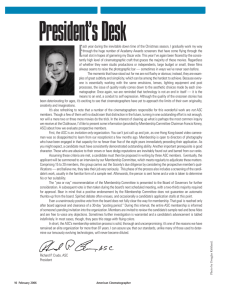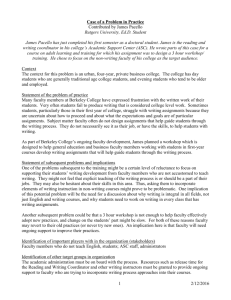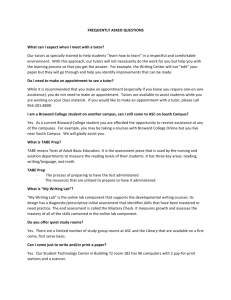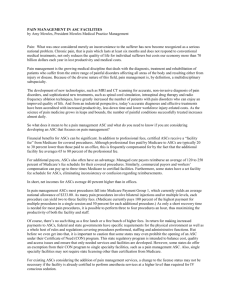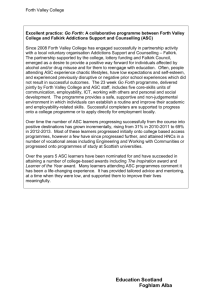ASC Transactions
advertisement
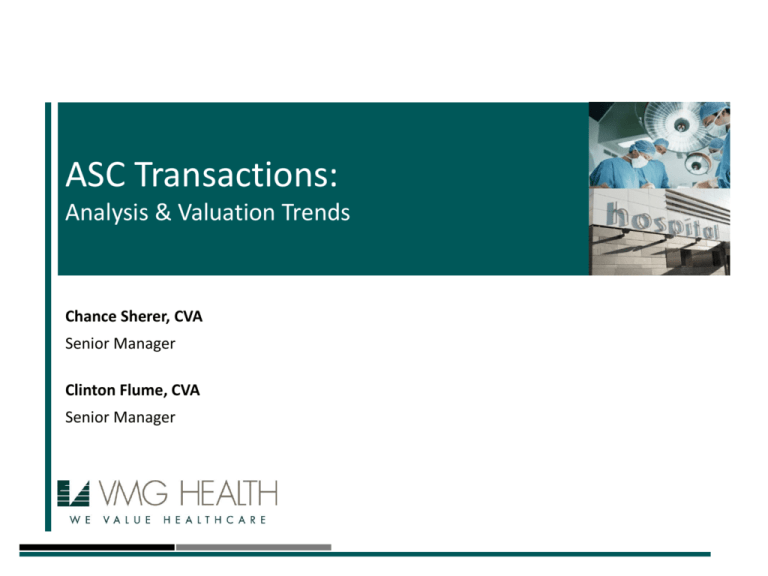
ASC Transactions: Analysis & Valuation Trends Chance Sherer, CVA Senior Manager Clinton Flume, CVA Senior Manager Presentation Overview I. Observation & Trends – Healthcare Market II. Observation & Trends – ASC Industry III. ASC Transaction Market IV. Valuation Trends V. What Does the Future Hold? I. Observation & Trends – Healthcare Market Current Market Observations Current Macro Healthcare Trends US healthcare spending is out of control 2012 Health Expenditures Per Capita Norway $9,055 Switzerland $8,980 United States $8,895 Luxembourg $7,452 Denmark $6,304 Australia $6,140 Canada $5,741 Netherlands $5,737 Austria $5,407 Sweden $5,319 Belgium $4,711 France $4,690 Germany $4,683 Iceland $3,872 United Kingdom $3,647 Italy $3,032 Spain Singapore Greece Portugal $2,808 $2,426 $2,044 $1,905 World Health Organization National Health Account database (see http://apps.who.int/nha/database/DataExplorerRegime.aspx) Page 4 Current Market Observations Current Macro Healthcare Trends Healthcare is currently 17.2% of GDP Healthcare spending in the United States grew 3.7% in 2012, which is slightly greater than the increase in 2010 By 2020, national health spending is expected to reach $4.5 trillion and comprise 19.2% of GDP Contrary to popular belief, healthcare spending appears to be slowing National Healthcare Spending as a % of GDP 20.0% 18.0% 16.0% 14.0% 12.0% 10.0% 8.0% 6.0% 4.0% 2.0% 0.0% 1960 1965 1970 1975 1980 1985 1990 1995 2000 2005 2010 2012 Page 5 Current Market Observations Current Macro Healthcare Trends In the chart below, year over year growth in healthcare expenditures is shown from 2000 to 2012. Contrary to projections of out of control growth, healthcare expenditures are shown to be decelerating. Percent Change in National Healthcare Expenditures 12.0% 9.7% 10.0% 8.5% 8.4% 8.0% 7.2% 7.0% 6.8% 6.5% 6.3% 6.0% 4.7% 4.0% 3.8% 3.8% 3.6% 3.7% 2009 2011 2012 2.0% 0.0% 2000 2001 2002 2003 2004 2005 2006 2007 2008 2010 Page 6 Current Market Observations Healthcare is Headed in a New Direction Fee-for-Service Shared Savings / Value Based Reimb. / Bundled Payments Physicians/Hospitals Acting Independently Physicians & Hospitals Collaborating ASC’s Operating Independently ASC’s Becoming Part of the Continuum of Care Strong Revenue Growth Cost Containment & Operating Efficiencies More Facilities/Capacity More Efficient Facilities/Consolidation Page 7 II. Observation & Trends – ASC Industry ASC Industry State of Industry – Two Observations: 1) Trends consistent with a mature industry 2) Possible revival of de novo development Recovery in volume post-recession was short-lived – signs of weakness in same center volume trends Continued managed care and Medicare reimbursement pressure Uncertainty regarding healthcare reform’s long-term impact on ASCs Page 9 ASC Industry All Signs Point to a Mature ASC Industry Growth in ASC Development has Leveled Off Same Center Growth has Flat-Lined ASC Supply Exceeds Physician Demand in Most Markets Significant Capacity at Many ASCs Growth in Observed ASC Mergers & Consolidation Initial Stages of Consolidation among ASC Management Companies Page 10 ASC Industry Slowdown in government ASC payments and new ASC construction point to a mature market Medicare ASC Payments and Certified ASCs, 2000-2011 6,000 $4,000 $3,500 5,000 $3,000 4,000 $2,500 3,000 $2,000 $1,500 2,000 $1,000 1,000 $500 0 $0 2000 2001 2002 2003 2004 2005 2006 2007 Medicare ASC Payments (in millions) 2008 2009 2010 2011 2012 Certified ASCs Page 11 ASC Industry Rebounding of OR Utilization From Dip in 2009 From 2007 to 2009, OR utilization declined by 16% before rebounding 15% from 2009 to 2011. Utilization appears to be leveling off. Median Cases per OR per Day 3.2 3.1 3.0 2.9 2.8 2.7 2.6 2.5 2.4 2.3 2007 2008 2009 Source: VMG Health Intellimarker ASC Benchmarking Study 2010 2011 2012 In many markets, we are seeing a revival of ASC de novo development – perhaps leading to decline in capacity utilization Page 12 ASC Industry Current Focus – Implementing Operational Efficiency Staff Hours Per Case De-Leveraging: Debt/Total Assets 60.0% 16.0 14.0 14.9 12.0 50.0% 14.0 10.0 10.4 11.0 8.0 10.0 11.0 40.0% 44.8% 49.0% 35.0% 30.0% 6.0 31.8% 31.8% 27.4% 20.0% 4.0 10.0% 2.0 0.0% 0.0 2007 2008 2009 2010 2011 2012 2007 2008 2009 2010 2011 2012 Source: VMG Health Intellimarker ASC Survey Observed a slight decrease in staffing efficiency in 2012, largely a result of decrease in same center volume trends. Page 13 ASC Industry Current Macro Healthcare Trends Supply of new physicians will likely not meet demand Page 14 ASC Industry Current Macro Healthcare Trends Aging physician demographic will further limit recruitment & volume Age 45 and over Age under 45 Number of Physicians (Thousands) Demographics of the Physician Workforce 650 600 550 500 450 400 350 300 250 200 150 100 50 0 50 100 150 200 250 300 350 400 Age Group 1980 – Approx 20% over Age 55 65 & Over 55-64 45-54 1990 – Approx 30% over Age 55 35-44 Under 35 1980 1990 2000 2012 – Approx. 43% over Age 55 2012 Source: “Physician Characteristics and Distribution in the US” by American Medical Association (2011 Edition) Page 15 ASC Industry Hospitals have ramped up physician employment to build integrated networks 2000 2012 Hospital Based, 25.3% Hospital Based, 18.7% Office Based, 81.3% Office Based, 74.7% Source: American Medical Association Page 16 ASC Industry ASCs and Physician Owned Hospitals (“POHs”) rely on the same physician investor pool Growth in ASCs and POHs has far exceeded growth in the physician pool 2-3% Annual Growth in Eligible Drs Number of Eligible Physicians per ASC 40 35 30 25 20 36 32 31 29 26 23 21 20 19 19 19 19 18 >40% Decline In Eligible Drs Per ASC/POH 15 10 5 0 2000 2001 2002 2003 2004 2005 2006 2007 2008 2009 2010 2011 2012 Page 17 ASC Industry What to Expect in a Mature Industry Environment? Attracting Physician Investment & Volume will be the Greatest Challenge Increase in ASC Mergers & Limited ASC Failure Increased Involvement of Hospitals in ASC Industry Expected Return for ASC Investors will be Moderated Existing ASCs will need to Focus Efforts on Implementing Efficiencies Page 18 III. ASC Transaction Market ASC Transaction Market In a Mature ASC Market, Who are the Buyers? Acute Care Hospitals ASC Management Companies Competing ASCs - Broader consolidation trend - Interested in expanding existing market presence - Merger Scenarios -Easy reimbursement arbitrage - JVs w/ Hospitals - Successful ASCs absorbing struggling ASCs Physician Owned Hospitals - Limited, Niche expansion play - Limited by Capacity / Ownership Restrictions - Goals of Cost Reduction Page 20 ASC Transaction Market The ASC Market Continues to Evolve… De Novo Development Management / Development Company JVs Hospital Acquisition / JVs New Wave of De Novo Development? Page 21 ASC Transaction Market ASC Acquisition History Merger& & Acquisition Acquisition Trends Merger Trends 30 30 25 25 20 20 15 15 10 10 5 5 0 0 2007 2007 2008 2008 2009 2009 NOVAMED SCA USPI 2010 2010 USPI AMSURG 2011 2011 AMSURG 2012 SCA 2012 2013 2013 NOVAMED Page 22 ASC Transaction Market Consolidating ASC Market: Graymark acquisition of Foundation Healthcare – 21 Centers USPI acquisition of Titan Health Corporation – 14 Centers Amsurg Corp. announces acquisition of National Surgical Care – 18 Centers Surgery Center Holdings, Inc. (Surgery Partners) acquisition of NOVA – 37 Centers Sunlink Health merger with Foundation HealthCare – 15 Centers USPI acquisition of HealthMark Partners – 14 ASCs SCA acquisition of Health Inventures – 20 Centers Page 23 Hospital Transaction Market Hospital M&A activity has been driven market consolidation, healthcare reform initiatives and cheap capital Activity has steadily risen over the last 5 years and was exceptionally high in 2012 The number of large, multi-site “chain” transactions has risen While the number of deals seems to have decreased in 2013, the number of hospitals and beds involved in transactions hit a 5-year high, mainly driven by two very large mergers Hospital Merger and Acquisition Trends 120 107 109 103 100 91 81 85 85 89 92 84 80 68 60 60 40 20 0 2002 2003 2004 2005 2006 2007 2008 Number of Deals 2009 2010 2011 2012 2013 Page 24 ASC Transaction Market Buyers are Keenly Aware of Their Own Company Valuations Both publicly traded and private companies are keenly aware of their Wall Street value Page 25 ASC Transaction Market Hospital Share Prices Reflected the Good News from the Passage of the Healthcare Law ASCs continue to have strong performance against the S&P regardless of Healthcare Reform Page 26 ASC Transaction Market Demand for Acquisitions is High Frothy stock market – particularly for healthcare Need for ASC management companies to exhibit growth Diminished ability to pursue growth through de novo development Same center performance does not provide growth investors expect Market consolidation strategies are being pursued aggressively Hospitals are joining management companies in the buyers market ASC attracts significant interest from private equity due to their high cash flow generating ability Page 27 IV. What is the Current Value of ASCs How is Valued Measured Valuation Methodologies Cost Approach Provides a Floor for Value – Tangible Assets + Identifiable Intangibles Valuation Impact – Last 12 Months Stable Income Approach Discounted Cash Flow Value – Measure Future Benefits of Ownership Market Approach What are Transaction Values of Comparable Companies Up Fair Market Value Opinion should Consider these Three Approaches to Value – the forces driving these approaches are dynamic Page 29 Income Approach Keys to Value Future Cash Flow – The ability of the ASC to generate cash flow to the investor after all operating expenses, capital requirements, and debt service Risk – The likelihood of projected levels of cash flows realized given the operating and strategic environment under which the ASC operates Valuation is not a one-size fits all – each ASC has unique growth and risk characteristics Page 30 Income Approach Primary Factors Affecting Future Cash Flow Market Patient Demographics Historical Performance Trends Case Mix / Service Line Mix Ownership Flexibility Facility Capacity Historical Recruitment Efforts/Ability Payor Mix – Mgd Care Strength Growth Potential Page 31 Income Approach Primary Factors Affecting Risk Out-of-Network Reliance on Exposure Non-Owner Physicians Financial Leverage (Debt Load) Legal / Partnership (Non-Compete) Facility & Equipment Age / Condition Physician Diversification Barriers to Entry (CON) Service Line Diversification Market Competition Healthcare Reform Stable Past Performance (Longevity) Page 32 Observed ASC Valuation Trends ASC Valuation Trends as Multiple of EBITDA 8.0 Acquisition Multiples have widened and trended up slightly in last 1-2 years Control Multiples Control Multiples 7.0 6.0 5.0 Minority Multiples 4.0 Minority multiples have Declined and Widened 3.0 2.0 1.0 0.0 2005 Present Page 33 ASC Market Transaction Minority Level ASC EBITDA Multiples Out-of-network minority 4.0x 3.0x valuation multiples have 2.0x declined until recently. 1.0x (2012, little misleading) 0.0x 2007 2008 2009 Minority Out-of-Network 2010 2011 2012 Minority In-Network Control ASC Transactions 6.5x Out-of-network control level 6.0x transactions and their valuation 5.0x multiples have declined over the last six years. 5.5x 4.5x 4.0x 3.5x 3.0x 2007 2008 2009 Control Out-of-Network 2010 2011 2012 Control In-Network Page 34 IV. What Does the Future Hold Reform and The Affordable Care Act HOPD / ASC Payment Equalization The Affordable Care Act - Individual Mandate - Health Insurance Exchanges Page 36 Reform and The Affordable Care Act In June 2013, MedPAC called for payment equalization between HOPDs and physician offices and ASCs for certain procedures In April 2014, the OIG recommended that CMS reduce OPPS payment rates for ASC-approved procedures on beneficiaries with no-risk or low-risk clinical needs in outpatient departments Under this recommendation, OP departments would continue to receive the standard OPPS payment rate for ASC-approved procedures that must be provided in an OP department because of a beneficiary’s individual clinical needs Assuming that total outpatient volumes continue to grow, payment equalization may push utilization to low cost facilities, such as ASCs and physician offices Page 37 Reform and The Affordable Care Act Rising premiums and deductibles may decrease utilization for procedures however push volume to lower cost settings like ASCs Insurers have vowed to raise premiums for small businesses and selfinsured individuals • UnitedHealth, Aetna, and the Blues have all cited premium increases of 25%-116% for 20141 Because of higher costs, small employers may drop coverage and pay mandate penalties This may cause consumers to adopt higher deductible, lower premium plans Page 38 Reform and The Affordable Care Act Consumers may already be changing behavior “So as you look at the trends over the past few years, you do see more of a shift towards the latter half of the year on the commercial book of business in the outpatient segment. So can you attribute all that to deductibles and co-pay? Possibly.” - Samuel N. Hazen, President of Operations, HCA, on sluggish first quarter outpatient volumes Private insurance rates continue to climb: Page 39 Conclusion – Uncertainty is Certain What Do We Know…Short Term Volume Retention will be Difficult: Recruiting and retaining physician investment will be single greatest challenge Competitive Share Price Succession Planning No dead weight in partnership Enforce Non-competes Poach from competition Form relationships with hospitals Reimbursement Challenges: Despite ASCs status as low-cost provider for outpatient surgery, material growth in reimbursement should not be counted on Evaluate Contracts Seek Affiliation with Hospitals Pursue Higher Acuity volume Know Profitability of Procedures Need to for ASCs to educate themselves on shared-risk (semi capitated) reimbursement models Page 40 Conclusion – Uncertainty is Certain What We Think We Know…Long Term Market Consolidation: Dominant health systems and payors will likely be in the driver’s seat…need to assess your specific market Changing Healthcare Delivery Models: Network Affiliations between Health Systems and Payors will narrow – ASCs will need to find a way to “fit in” The ASC industry was founded by entrepreneurial and fiercely independent physicians…..pursuit of stubborn independence moving forward could leave those ASCs on the outside looking in. ASC management must be proactive in assisting their individual physicians and physician groups navigate and find their role in the healthcare delivery network There may be an eventual need to look at your ASC as a provider in a broader network, not as a primary surgical site for a handful of specific surgeons. Page 41 Questions? Chance Sherer, CVA Senior Manager ChanceS@vmghealth.com 214.369.4888 Clinton Flume, CVA Senior Manager ClintonF@vmghealth.com 214.369.4888 Page 42

